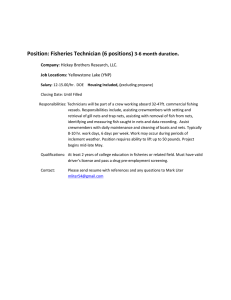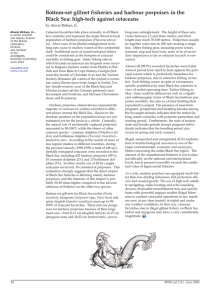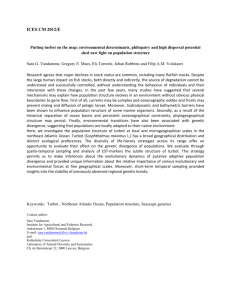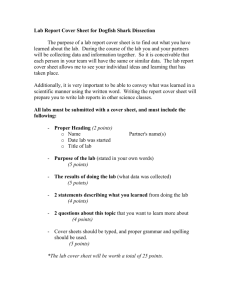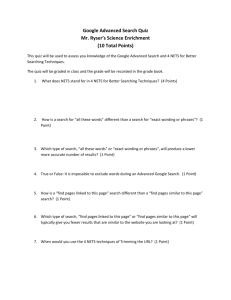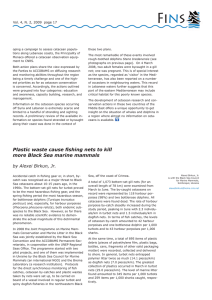Document 13895587
advertisement
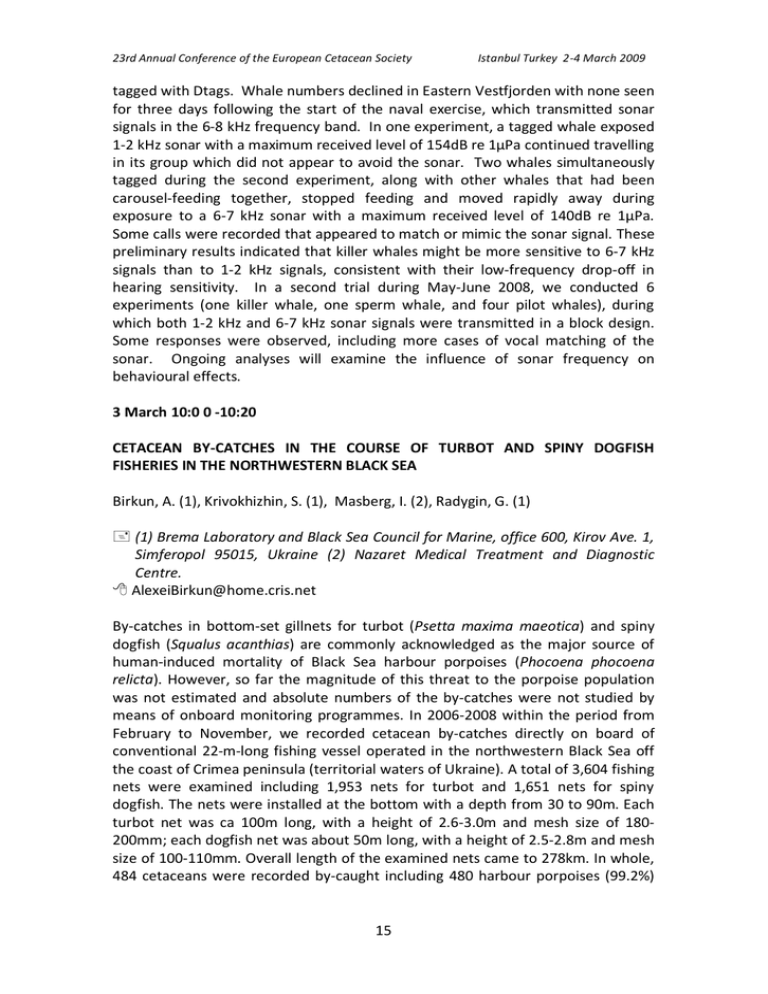
23rd Annual Conference of the European Cetacean Society Istanbul Turkey 2-4 March 2009 tagged with Dtags. Whale numbers declined in Eastern Vestfjorden with none seen for three days following the start of the naval exercise, which transmitted sonar signals in the 6-8 kHz frequency band. In one experiment, a tagged whale exposed 1-2 kHz sonar with a maximum received level of 154dB re 1μPa continued travelling in its group which did not appear to avoid the sonar. Two whales simultaneously tagged during the second experiment, along with other whales that had been carousel-feeding together, stopped feeding and moved rapidly away during exposure to a 6-7 kHz sonar with a maximum received level of 140dB re 1μPa. Some calls were recorded that appeared to match or mimic the sonar signal. These preliminary results indicated that killer whales might be more sensitive to 6-7 kHz signals than to 1-2 kHz signals, consistent with their low-frequency drop-off in hearing sensitivity. In a second trial during May-June 2008, we conducted 6 experiments (one killer whale, one sperm whale, and four pilot whales), during which both 1-2 kHz and 6-7 kHz sonar signals were transmitted in a block design. Some responses were observed, including more cases of vocal matching of the sonar. Ongoing analyses will examine the influence of sonar frequency on behavioural effects. 3 March 10:0 0 -10:20 CETACEAN BY-CATCHES IN THE COURSE OF TURBOT AND SPINY DOGFISH FISHERIES IN THE NORTHWESTERN BLACK SEA Birkun, A. (1), Krivokhizhin, S. (1), Masberg, I. (2), Radygin, G. (1) (1) Brema Laboratory and Black Sea Council for Marine, office 600, Kirov Ave. 1, Simferopol 95015, Ukraine (2) Nazaret Medical Treatment and Diagnostic Centre. AlexeiBirkun@home.cris.net By-catches in bottom-set gillnets for turbot (Psetta maxima maeotica) and spiny dogfish (Squalus acanthias) are commonly acknowledged as the major source of human-induced mortality of Black Sea harbour porpoises (Phocoena phocoena relicta). However, so far the magnitude of this threat to the porpoise population was not estimated and absolute numbers of the by-catches were not studied by means of onboard monitoring programmes. In 2006-2008 within the period from February to November, we recorded cetacean by-catches directly on board of conventional 22-m-long fishing vessel operated in the northwestern Black Sea off the coast of Crimea peninsula (territorial waters of Ukraine). A total of 3,604 fishing nets were examined including 1,953 nets for turbot and 1,651 nets for spiny dogfish. The nets were installed at the bottom with a depth from 30 to 90m. Each turbot net was ca 100m long, with a height of 2.6-3.0m and mesh size of 180200mm; each dogfish net was about 50m long, with a height of 2.5-2.8m and mesh size of 100-110mm. Overall length of the examined nets came to 278km. In whole, 484 cetaceans were recorded by-caught including 480 harbour porpoises (99.2%) 15 23rd Annual Conference of the European Cetacean Society Istanbul Turkey 2-4 March 2009 and four bottlenose dolphins, Tursiops truncatus ponticus (0.8%; detected in turbot nets only). At the same time, total catch of target fish species (including commercially suitable specimens and discards) amounted to 4751 turbots and 1830 dogfishes in turbot and dogfish nets, respectively. All the cetaceans on record were found dead. General by-catch indices rounded to integers were evaluated as follows: 163 P.p.relicta and two T.t.ponticus per 100km of turbot nets; 195 P.p.relicta per 100km of dogfish nets; 67 P.p.relicta and one T.t.ponticus per 1000 turbots, and 88 P.p.relicta per 1000 dogfishes. Peaks of harbour porpoise bycatches occurred in June (2.70 per 1km of turbot nets) and August (7.55 per 1km of dogfish nets). 3 March 10:20 -10:40 MARINE MAMMAL AND FISHERIES INTERACTIONS IN GALICIA, NORTH-WEST SPAIN Read, F. (1), Martínez-Cedeira, J. (2), Gonzalez, A. (1), López, A. (2), Santos, B.M. (3), Pierce, G.J. (3,4) (1) Instituto de Investigaciones Marinas (C.S.I.C), Centro Oceanográfico de Vigo, Instituto Espańol de Oceanografía (IEO), Cabo Estay - Canido, Apartado 1552 36200, Vigo, Spain (2) CEMMA (3) Instituto Español de Oceanografía (4) University of Aberdeen fiona.read@vi.ieo.es Galicia, north-west Spain, is one of the world’s main fishing regions and fishing is an important component of the economy. Previous interview surveys with fishermen five and ten years ago highlighted a high (up to 1700 cetaceans per year) and potentially unsustainable cetacean by-catch rate. Pair trawls and gillnets reported the highest by-catch rates, with Delphinus delphis being the most commonly bycaught species. Since 1990, necropsies of over 1800 stranded and by-caught have been conducted, and around 1/3 of these animals were fresh enough (state 1-3) to detect indications of fisheries interactions, if present. Of these, approximately 12% were of known by-catch and a further 36% had indications of fishery interactions such as net marks and mutilations. Tursiops truncatus and Phocoena phocoena are the most commonly sighted cetaceans in Galician coastal waters although the number of strandings is much lower than for Delphinus. Around 1/5 of Tursiops and 1/3 of Phocoena strandings show evidence of fisheries interactions. Age, maturity and pregnancy data from stranded animals are used to construct life tables and make estimates of overall mortality and reproductive rates. Analysis of Delphinus delphis life-history samples shows that males were caught more frequently than females, and juvenile and sub-adult males were more frequently by-caught than older males. Results from the life table indicate that there is a 13% annual mortality in the Delphinus delphis population, about half of which is apparently due to fisheries interactions. This greatly exceeds the 2% by-catch limit set by ASCOBANS. 16
